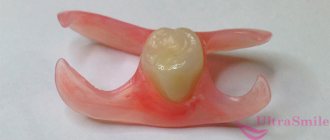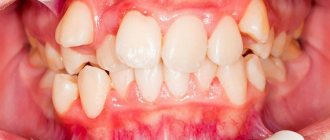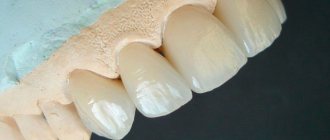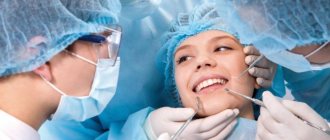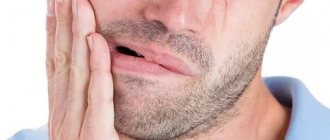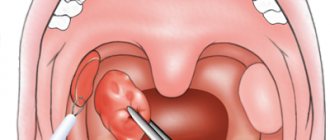When is root removal required?
It happens that only the root remains in the gum, and its crown part has been completely lost due to mechanical stress or untreated caries. After an X-ray examination, CELT specialists determine the possibility of treating such roots and their further use as a support for the crown. If this is not possible and the tissue surrounding the root is changed, a decision is made to remove it. Indications for root removal of front, broken, baby and other teeth are:
| Indications | Reasons for deletion |
| Serious damage to the crown of the tooth | Complete fracture of the crown, complex transverse fracture, fracture along the lobar axis, as well as destruction of the tooth crown below the gum level |
| Inflammatory processes | Development of inflammation in the root area in the form of a cyst, granuloma, abscess or phlegmon |
| Dentofacial anomaly | The tooth that is to be removed has an atypical location and prevents other teeth from growing, injures the gums and causes discomfort |
| Movable root | Third degree of tooth mobility |
It is worth noting that the crown part of the tooth can be destroyed both on a tooth with a nerve and on a pulpless tooth. If the tooth is “alive” and the destruction of its coronal part is not severe, its preservation is quite possible. As for a tooth with a removed root, the latter, as a rule, are seriously damaged and their restoration is quite difficult. In this case, the doctor may recommend removal of the tooth root and subsequent implantation.
Indications for extirpation
Tooth extraction in clinics in St. Petersburg can be either emergency or planned. Emergency surgery on the day of treatment is indicated for acute inflammation of soft gum tissue, purulent separation from the tooth and gum, fracture of the coronal part and acute pain.
Planned (planned in advance) extirpations are carried out by doctors in a variety of situations:
- a tooth is subject to extraction if its further treatment is impossible due to any peculiarities (too thin walls after filling, root perforation, pulpitis and advanced caries, uneven roots, etc.);
- for periodontitis and its complications;
- removal of a complex impacted dystopic tooth (with incomplete eruption or abnormal growth);
- with incorrect positioning of the dental unit, shifting of the remaining teeth to the side, permanent injuries to the gums and cheek tissues;
- when planning to correct the bite or position of units using orthodontic devices;
- Removal of an impacted (atopic) tooth in the upper or lower jaw is often recommended when the trigeminal facial nerve is affected.
Removing the root of a decayed tooth
Cases where a root remains after tooth extraction are not uncommon. Its removal is a difficult and unpleasant procedure for the patient, even despite the effectiveness of modern anesthesia. Fortunately, the need to remove tooth roots does not always arise. If the root is healthy enough, it is treated and prosthetics are performed. However, removing a rotten tooth root is simply necessary, since its preservation will entail a number of problems:
- Halitosis (bad breath);
- A breeding ground for infection in the oral cavity, possible damage to neighboring teeth;
- The appearance of subgingival stone;
- Spread of infection to the maxillary sinuses, development of osteomyelitis;
- The appearance of cysts and granulomas at its apex ( removing a tooth with a cyst on the root
is a complex procedure); - A decrease in the body’s overall immunity due to the fact that it is forced to constantly fight the source of inflammation.
In order to properly plan the operation, our dentist performs an x-ray examination. The operation itself is performed using local anesthesia, dental forceps or an elevator. Removing the roots of the front teeth
is carried out using rotational movements, and lateral movements using rocking. The most complex cases may require additional manipulations, the use of burs and special microsurgical dental instruments. Removing the roots of the teeth of the lower and upper jaw is a more complex procedure than removing a whole tooth. It requires special training, which consists of examination, diagnosis and sanitation of the oral cavity. The treatment plan is drawn up based on diagnostic studies and the patient’s indications.
Postoperative care
First, the dentist asks the patient to bite on a piece of gauze. After 45 minutes it can be removed. During this time, the blood will clot; you cannot eat or drink hot food for two hours on this day. To prevent the gums from swelling too much, you can apply cold compresses to the cheek. It is advisable to sleep on your back, placing additional pillows under the back of your head. This will prevent your cheek from swelling. If after a complex tooth extraction the pain is quite severe, the dentist will recommend a suitable painkiller.
The doctor will definitely give some more important tips regarding postoperative care:
- On the first day after simple, complex or atypical tooth extraction, it is forbidden to rinse your mouth.
- On the day of visiting the doctor and the next day, you should eat only soft foods. You should chew carefully, trying to use teeth that are far from the extraction site.
- The remaining teeth can be brushed, but those located next to the socket should not be touched.
- From the second day, you can begin to steam the area where the extracted tooth was located with warm salted water before going to bed.
Root removal steps:
- Carrying out activities for the administration of a local anesthetic drug;
- Separation of the circular ligament from the neck of the tooth, moving the gum tissue away from the edge of the alveolus;
- Cutting the gums and drilling out the bone tissue to provide access to the root (if necessary);
- The process of removing the root using forceps or a dental elevator. If a tooth has several roots, removal is carried out in parts;
- Treatment of the hole, suturing (if the gum is cut), treatment of the operated area.
It is important to understand that removing roots located on the upper jaw is different from removing roots located on the lower jaw. In the first case, special forceps are used, in the second - elevators. The technique for removing the roots of the upper jaw involves twisting single roots and dislocating parts of one root. As for the roots of the lower jaw, they are twisted.
Types of Impacted Teeth
The position of an unerupted tooth inside the gum varies, and depending on how it is located there, the doctor decides whether to remove the tooth or relieve inflammation and allow the tooth to erupt.
Degree of retention:
Complete (the tooth is completely hidden by the gum and bone, it cannot be seen or felt. Most often this refers to impacted wisdom teeth);- Partial (a small part of the crown is visible, the rest is hidden);
- Retention in hard tissues (bones);
- Retention in soft tissues (gums).
Inclination of impacted tooth and crown:
- Mesial (the tooth is slightly tilted forward - this is the type of retention that most often occurs);
- Vertical (the tooth grows correctly, but cannot erupt due to lack of space);
- Horizontal (the tooth lies completely inside the gum or bone with the tip facing the other teeth);
- Distal (tooth tilted back).
In addition, although quite rare, retention occurs not of one tooth, but of several adjacent teeth of the same type (for example, two molars). This problem most often occurs in children.
How much does tooth root removal cost in Moscow?
The cost of tooth root removal is determined individually, as it depends on how complex the case is. In the dental department of the multidisciplinary clinic CELT, it starts from 800 rubles for a simple removal and ends at 10,000 rubles for a complex removal of a 2nd degree dystopic tooth. You can view our basic prices in this section of our website. In order to find out the exact cost of tooth root removal in our clinic in Moscow, consult our specialist.
In the dentistry of the CELT clinic, you can get a consultation with a dental surgeon, undergo an examination and remove the roots of the teeth, if there are indications for this. We will eliminate any dental problems effectively and absolutely safely.
Causes of dystopic wisdom teeth
Most experts agree that the main cause of dystopic teeth is genetic predisposition. This is also true in the case of wisdom teeth: if the structural parameters of the parents’ jaws contributed to the occurrence of such an anomaly, then their children also have a high risk of developing dystopic teeth. In addition to genetics, there are a number of other factors that influence the position of the wisdom tooth during eruption:
- incorrect formation of tooth buds at the stage of intrauterine development;
- malocclusions, including those caused by mechanical damage;
- macrodentia, presence of supernumerary teeth, small jaw;
- early loss of baby teeth.
Reviews of doctors providing the service - Tooth root removal
I would like to express my gratitude to the dentist Elena Nikolaevna Kiseleva and her assistant Svetlana - they are real specialists and at the same time sensitive, not burnt out by years of practice.
Thanks to them, I have been coming back here for many years. Thanks to the management for such doctors! Read full review Svetlana Nikolaevna
13.08.2021
I am very grateful to Evgeniy Borisovich Antiukhin for removing my three eights. Especially considering that the lower tooth was not the simplest (it was located in an embrace with a nerve). The removal took place in 2 stages, one tooth under local anesthesia, two under general anesthesia. I had no idea that wisdom teeth could be... Read full review
Sofia
28.12.2020
Tooth extraction surgery
Tooth extraction surgery is the most common human surgery. It can be typical (simple), complex, atypical. The main goal of a typical (simple) tooth extraction operation is the need to create conditions for the tooth to emerge from the jaw, that is, it is necessary to destroy the connection of the tooth with the surrounding tissues and slightly expand the alveolus. During surgery, the doctor usually stands (or sits) on the right side of the patient. However, the position of the doctor, the patient in the chair and the tilt of the patient’s head should be such that it is comfortable for the doctor to work and for the assistant to help. The dentist and assistant must have a clear view of the surgical field and be able to control the condition of the oral cavity and fix the jaw and alveolar process near the tooth that is being removed with their left hand.
Stages of tooth extraction
The following mandatory stages of a simple tooth extraction operation are distinguished, which are carried out after anesthesia:
- syndesmotomy - detachment of the mucous membrane from the tooth and destruction of the upper parts of the dental-gingival junction;
- applying forceps to a tooth
- advancement of forceps
- fixation of forceps
- loosening of the tooth (luxation or rotation, depending on the shape of the tooth root)
- traction - removing a tooth from the alveolus
- hole revision
- treatment of the tooth alveolus (reposition or suturing of its edges)
Simple tooth extraction
Apply forceps so that their axis coincides with the axis of the tooth, advance the forceps until they come into contact with the neck of the tooth and the edge of the alveolus.
Applying the cheeks of the forceps to the tooth (a - correct; b - incorrect) and to the upper edges (c) of the walls of the tooth socket (this is undesirable, since bone is lost)
You need to squeeze the forceps so as not to split the tooth, especially if it is fragile or has a carious cavity. After applying the forceps, the first luxation movement is usually made in the direction of the thinnest wall of the tooth alveolus (usually outward in the buccal direction), so that it breaks and enlarges the opening for the tooth.
In the lower jaw, when removing molars, the first movement is made in the lingual direction, because on the outside there is an external oblique line (buttress of the lower jaw), which counteracts the force that is applied. After the operation, the edges of the alveoli are brought together with fingers, and if necessary, the mucous membrane over the alveoli can be sutured with catgut, silk, or a pressure bandage (a tampon that the patient presses with his teeth to stop bleeding from the alveoli) can be applied to it. It should be noted that the extracted tooth is not immediately thrown away, but is examined and shown to the patient to avoid questions about the need to remove the tooth and the presence of all its roots.
The classical technique of tooth extraction surgery has some features when removing various teeth, which is determined by the number and structure of their roots, the alveolar process and the jaw itself, the nature of the pathological process in the area of the alveolar process, the degree of destruction of the tooth, its position in the jaw, characteristics of soft tissues and other factors . Teeth with rounded roots (canines, central incisors) are removed with a predominant use of rotational movements, and teeth with flat roots or multi-rooted teeth are removed with a predominance of luxation movements. The force of tooth dislocation must correspond to the resistance of the bone of the walls of the tooth socket.
The use of a particular elevator, as well as the direction of the first luxation movement (inward or outward) also depends on the above factors. Thus, a direct elevator is usually placed on the medial surface of the tooth and rotational movements are carried out with the elevator based on the alveolar bone or medially located teeth, which will make it possible to remove teeth or their roots. An angular elevator is inserted into the alveolus of an already removed tooth root and also carries out a rotational movement in the direction of the root and interradicular septum, which are subject to simultaneous removal.
Scheme of removing the root of the upper tooth with a straight elevator (a - d - stages of the operation) and removing the roots of the lower molars with an angular elevator (according to A. E. Verlotsky) (e)
Features of root anatomy and tooth extraction in the upper jaw
- Front incisors - their roots have a rounded shape. Use straight forceps; rotational movements, dislocation - in the direction of the vestibule of the oral cavity.
- The lateral incisors are slightly flattened, the apex is curved towards the sky. Rotational and luxation movements are used.
- Fangs - roots are massive, long, flattened, like a aligned triangle. The forceps are straight, the movements are luxation, then rotation.
- Premolars - the roots are flattened, the first premolar has 50% buccal and palatal roots. The forceps are S-shaped, the movements are luxation, the first movement is made in the buccal direction.
- Molars - the first two (6 and 7) have three roots: two buccal and one palatal. In the area of the 6th tooth, the outer wall of the alveolus is thickened due to the zygomatic-alveolar ridge, and in the area of the 7th tooth, the outer wall is thinner than the inner. An S-shaped forceps with a spike on the outer cheek is used to bifurcate between the buccal roots. The first luxation movements are towards the palate (6th tooth) or outwards (7th tooth).
- The upper 8 teeth are removed with special bayonet forceps with long cheeks, the first movement is outward. Often they can only be removed using a direct elevator.
- The roots of the upper teeth are removed with bayonet forceps or straight and S-shaped forceps with cheeks that meet. The roots of the upper molars are removed either all together (while maintaining the connection between them), or one by one (when the connection is already destroyed, the roots are single).
Features of the anatomy of roots and tooth extraction in the lower jaw
The patient's position is as low as possible, the head is almost vertical, the chin is tilted towards the chest. When removing left teeth, the doctor stands to the right and in front near the patient, the first finger covers the chin, 2 and 3 fingers cover the alveolar process, and when removing right teeth, the doctor stands immediately behind the patient, 1-2 fingers of the left hand cover the alveolar process, and 3-4 5 fingers - chin, holding the lower jaw.
The line of strength (thick cortical plate) comes from the lingual surface in the area of 1-2-3 teeth, gradually passes at the level of 4-5 to the outer surface and at the level of 6-7-8 teeth passes into the external oblique line (buttress of the lower jaw). Taking this into account, the first luxation movement is carried out, gradually increasing the amplitude of movements, and rotational movements are also used. Traction of the tooth is carried out upwards and outwards so as not to injure the upper teeth.
- Incisors - roots flattened laterally, narrow beak-shaped forceps are used, movements are mainly luxation.
- The canines are long-rooted, strong, use wide beak-shaped forceps, movements are luxational and rotational.
- Premolars have one root, round in shape, slightly flattened. Movements - luxation and rotation.
- Molars (6, 7) have two flattened roots (anterior and posterior). Beak-shaped forceps with spikes, the first luxation movement of the 6th tooth is towards the buccal side and the 7th tooth is towards the lingual side. 8th tooth - the structure of the roots (there are 1-4 of them) can be multivariate, so removing a tooth is very difficult, even after an X-ray examination. They use special forceps with spikes, elevators, and often perform complex or atypical removal.
Complex tooth extraction
If a typical operation does not allow tooth extraction, then they proceed to a complex tooth extraction operation. Complex tooth extraction involves the use of additional surgical techniques and instruments to remove a root or tooth from the alveolus without opening and detaching the mucoperiosteal flap and without partially or completely removing one or two bone walls of the alveolus. To do this, additional tools and means are used - bone burs and drills, narrow chisels, a dental mirror and additional illumination of the fossa, various probes, narrow elevators, and other tools.
First of all, you need to accurately determine the presence, position and size of a broken tooth root, and the proximity of important adjacent anatomical structures. To do this, after drying and illuminating the hole with a mirror, it is carefully examined, radiographs are taken, or the position of the root is determined during surgery.
All methods of complex tooth extraction are conventionally divided depending on the degree of destruction of the walls of the fossa in order to expose the root of the tooth, or according to the impact on the tooth - removing the remains of the tooth completely or fragmenting the remains of the tooth and removing its fragments one by one.
The following surgical techniques are used that are indicated in the presence of a single-rooted tooth or an isolated root of a two- or three-rooted tooth (mainly in the upper jaw), an unfilled root canal, and the absence of hypercementosis of the tooth root:
- submucosal subperiosteal application of the cheeks of forceps to the upper edge of the alveolus of the tooth, squeezing and simultaneously removing the root of the tooth and the upper edge of the alveolus, but this is not optimal, since part of the bone of the fossa is lost
- removing the bone from the top of the hole around the root with a bur so that you can dislocate the root outward with a long elevator-stroker or use narrow long forceps (bayonet) to fix and remove it
- use a bur to expose the entire length of the tooth root on one side, then remove it using a scaling hook or an excavator
- push the apex of the tooth root out of the hole with any straight instrument, for example a straight elevator, which is inserted through an incision in the mucous membrane and the outer wall of the tooth alveolus perforated with a bur in the area of the root apex
- After visualizing the root canal, a cone-shaped screw with a strong thread and a handle is tightly inserted into it, the screw is securely fixed in the canal, the screw is gradually turned by hand several times in the direction of tightening the thread and the screw is pulled out. After such combined movements, the root is freed from the hole and removed (if the intraradicular screw does not enter the root canal, it is carefully expanded)
- after inserting a screw into the root canal, a special device is used to create mechanical traction to remove the tooth root
- expansion of the tooth fossa without exposing it - use a hand-held cylindrical cutter of the required diameter with a ratchet, round with the diameter of the root, to remove bone around the root along its length, followed by removal of the tooth root
- separation of the tooth with a bur (or chisel) in the zone of root connection into separate parts of the tooth and root, followed by alternate removal of roots and tooth fragments alone
Scheme of a complex tooth extraction operation - separation of the roots of the teeth with a bur and their alternate removal with an elevator: a - d - stages of the operation
They also use other surgical techniques and their combinations, instruments for complex removal of teeth and their roots, taking into account specific clinical conditions. After the operation, the tooth socket is treated in a typical manner. Only after the failure of a complex tooth extraction operation do they proceed to an atypical tooth extraction operation.
Atypical tooth extraction
The operation of atypical tooth extraction consists of opening the bone of the alveolar process of the jaw in the area of the tooth, removing 1-2 sides of the root of the tooth or the bone of the tooth socket, exposing the tooth and removing it. This operation is quite complex and traumatic.
Indications: fracture of the tooth root and the inability to remove it typically with forceps due to the small size of the root that remains, fragility of the root after endodontic treatment or hypercementosis, significant curvature and atypical structure of the roots of the tooth, dystonia and inclusion of teeth when their typical removal is impossible, insufficient mouth opening due to various reasons. Sometimes the need to perform an atypical extraction is due to a lack of tools, equipment, or an insufficient level of qualifications of the doctor, who does not sufficiently master the technique of typical and complex tooth extraction.
There are generally accepted contraindications to the operation of atypical tooth extraction, to which can be added the doctor’s uncertainty regarding his ability to carry out such an operation, the insurmountable reluctance of the patient to continue the extraction, who is already tired of the operation, insufficient organizational capabilities of the surgical room (shortage of tools, equipment, etc.) , a difficult clinical situation and the inability to perform the operation on an outpatient basis. It should be emphasized that in the case of a difficult clinical situation, the doctor should not continuously continue the operation fruitlessly, trying to typically remove a tooth and only further injuring nearby tissues. It is necessary to move in a timely manner to other surgical instruments and surgical techniques that are more effective and appropriate in new specific clinical conditions.
Incisional options for atypical tooth root removal
For atypical tooth extraction, the following instruments are used: scalpel, raspatory, hemostatic clamps, needle holders, dental mirrors, bone burs and cutters of various types and sizes, straight and angled dental handpieces, needles, suture material, Farabeuf hooks, chisel and hammer, bone nippers, syringes for washing the wound and other instruments. However, a hammer and chisel can only be used as a last resort, since this negatively affects the state of the brain, the general somatic and psychological state of the patient, and leaves him with unpleasant memories of the operation if it is carried out while the patient remains conscious.
An atypical tooth extraction operation usually involves the following steps:
- dissection of the mucous membrane and periosteum
- detachment of the mucoperiosteal flap
- removal of the necessary (usually the outer) walls of the alveoli and exposure of the tooth root
- dislocation (root) of a tooth from its socket
- tooth root removal
- revision and treatment of the alveoli
- mobilization of the mucoperiosteal flap
- closing the surgical wound by placing a mucoperiosteal flap in place and suturing the surgical wound. If necessary, additional fragmentation of the tooth or its roots is carried out during the operation.
Stages of atypical tooth extraction surgery. 1, 2 — dissection and detachment of the flap; 3, 4 — removal of the outer wall of the fossa; 5, 6, 7, 8 - separation and removal of tooth roots; 9 - sewn wound (according to V. A. Evdokimov)
This operation is complex and must be performed by highly qualified doctors with the help of an assistant in appropriate clinical conditions. The patient's position is lying or half-sitting in a chair, in good lighting. The operation requires high-quality anesthesia, the availability of all necessary instruments, and often premedication, medication and postmedication.
If a tooth (root) penetrates into the maxillary sinus (upper molars and premolars) or into the soft jaw tissue (the lower wisdom tooth and lower molars are most often displaced into the pterygomandibular space), they must be removed as quickly as possible (to prevent the development of neck phlegmon , pterygomandibular space, acute or aggravated sinusitis) in a hospital setting. These operations are complex, can take a long time and lead to serious complications.
Preparing a patient for a planned operation of atypical tooth extraction should be consistent and, first of all, include complete therapeutic sanitation of the oral cavity: removal of dental plaque, filling of carious cavities, treatment of acute periodontal diseases and mucous membranes. Immediately before the operation, rinse the mouth with antiseptic solutions. From the point of view of general and local preparation, it is usually typical, with the exception of cases of removal of impacted and semi-impacted teeth, when it is necessary to foresee in advance all possible features of the operation, warn and psychologically prepare the patient, premedicate him, and also prepare all the necessary tools and equipment, prepare in advance the necessary orthopedic devices (mouth guards, bite plates, etc.).
In the postoperative period, the patient is prescribed anti-inflammatory, painkillers and restorative medications to prevent inflammatory complications (especially if a tooth is removed in a functionally active place - a wisdom tooth), and the patient is monitored until the wound is completely healed. The wound can heal by primary intention, and then the alveolus of the tooth and the bone defect around it become a closed space. Sometimes suppuration of the wound and separation of its edges are noted, and then healing occurs by secondary intention.
Complications of the operation: inflammatory (myositis, suppuration of the surgical wound, periostitis, osteomyelitis, lymphadenitis, etc.), neurological (neuritis of the mandibular nerve, dental plexus, nerve sensitivity disorders), anatomical disorders (formation of defects in the alveolar process of the jaws, penetration of the maxillary sinus or nasal cavity , prolonged pain, fractures of the lower jaw, etc.).
zubodont.ru
